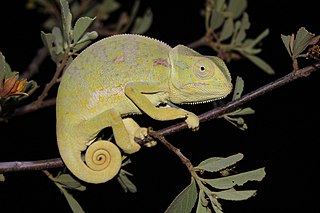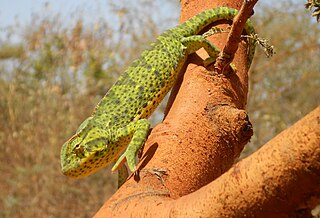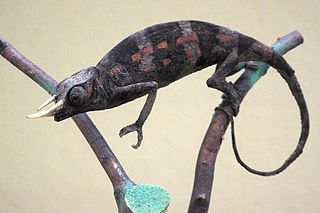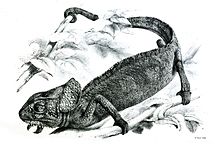
Socotra or Soqotra, located between the Guardafui Channel and the Arabian Sea, is the largest of the four islands in Socotra Archipelago. The territory is located near major shipping routes and is officially part of Yemen, and had long been a subdivision of Aden Governorate. In 2004, it became attached to the Hadhramaut Governorate, which is much closer to the island than Aden. In 2013, the archipelago became its own governorate: Socotra Governorate.

The veiled chameleon is a species of chameleon native to the Arabian Peninsula in Yemen and Saudi Arabia. Other common names include cone-head chameleon and Yemen chameleon.

The Indian chameleon is a species of chameleon found in Sri Lanka, India, and other parts of South Asia. Like other chameleons, this species has a long tongue, feet that are shaped into bifid claspers, a prehensile tail, independent eye movement, and the ability to change skin colour. They move slowly with a bobbing or swaying movement and are usually arboreal. Strangely, they do not choose the background colour and may not even be able to perceive colour differences. They are usually in shades of green or brown or with bands. They can change colour rapidly and the primary purpose of colour change is for communication with other chameleons and for controlling body temperature by changing to dark colours to absorb heat.

The Socotra sparrow is a passerine bird endemic to the islands of Socotra, Samhah, and Darsah in the Indian Ocean, off the Horn of Africa. The taxonomy of this species and its relatives is complex, with some authorities, including BirdLife International, recognising this species and the very similar Abd al-Kuri sparrow, as well as several from mainland Africa, as separate, and others lumping all these species and the probably unrelated Iago sparrow.

The Socotra cormorant is a threatened species of cormorant that is endemic to the Persian Gulf and the south-east coast of the Arabian Peninsula. It is also sometimes known as the Socotran cormorant or, more rarely, as the Socotra shag. Individuals occasionally migrate as far west as the Red Sea coast. Despite its name, it was only confirmed in 2005 that it breeds on the Socotra islands in the Indian Ocean.
The Socotra buzzard is a medium to large bird of prey that is sometimes considered a subspecies of the widespread common buzzard. As its name implies, it is native to the island of Socotra, Yemen. Although it is listed as vulnerable in the IUCN Red List, its population is considered to be stable.

The Socotra Island xeric shrublands is a terrestrial ecoregion that covers the large island of Socotra and several smaller islands that constitute the Socotra Archipelago. The archipelago is the western Indian Ocean, east of the Horn of Africa and south of the Arabian Peninsula. Politically the archipelago is part of Yemen, and lies south of the Yemeni mainland.

The coarse chameleon, Trioceros rudis, also known as the rudis chameleon, Ruwenzori side-striped chameleon or the Rwenzori bearded chameleon is a chameleon from western Uganda, Rwanda, Burundi, and eastern DR Congo. Contrary to common belief, this species does not inhabit Mount Meru, Tanzania. Tanzania chameleons called T. rudis are in fact T. sternfeldi.

The flap-necked chameleon is a species of arboreal chameleon, a lizard in the family Chamaeleonidae. The species is native to sub-Saharan Africa. There are eight recognized subspecies, including the nominotypical subspecies.

The Abd al-Kuri sparrow is a passerine bird endemic to the small island of Abd al Kuri in the Socotra archipelago of the Indian Ocean, off the Horn of Africa. Though this species was originally described as a distinct species, it was considered conspecific with the Socotra sparrow. A study by Guy Kirwan showed significant differences from the Socotra sparrow, and that the two sparrows might even have different origins. On the evidence that it is morphologically distinct, BirdLife International recognised it as a species, and it was listed in the IOC World Bird List from December 2009. It has a very restricted distribution, and a population of under 1,000 individuals, so despite not having any known threats it is considered a Vulnerable species on the IUCN Red List.

Furcifer belalandaensis, also commonly known as the Belalanda Chameleon or the Sangoritan'i Belalanda, is a species of chameleon that is endemic to Madagascar. It was identified and described by Édouard-Raoul Brygoo and Charles Antoine Domergue in 1970. The International Union for Conservation of Nature rated this species as Critically Endangered on their Red List of Threatened Species. The World Wide Fund for Nature is trying to save this species from extinction.

Furcifer tuzetae is a species of chameleon that is endemic to Madagascar. It is only known from its type locality, Andrenalamivola near Befandriana Sud. It was described by Édouard-Raoul Brygoo, Robert M. Bourgat and Charles Antoine Domergue in 1972. The International Union for Conservation of Nature have rated this species as "data deficient".

Furcifer petteri, also known as Petter's chameleon, is a species of chameleon, which is endemic to northern Madagascar. Furcifer petteri was initially described as the subspecies Chamaeleo willsii petteri by Édouard-Raoul Brygoo and Charles Domergue in 1966, but later transferred to the genus Furcifer and given full species status by Frank Glaw and Miguel Vences in 1994.
The spiny-flanked chameleon, Trioceros laterispinis, is a species of chameleon endemic to the United Republic of Tanzania, East Africa. It was first described in 1932 by Arthur Loveridge.

The crested chameleon, Trioceros cristatus, is a species of chameleon endemic to Africa. The species was first described by Samuel Stutchbury in 1837.

The Senegal chameleon, Chamaeleo senegalensis, is a species of chameleon native to West Africa. Its range includes Senegal, Mali, Nigeria, and Cameroon, and it lives in moist savanna. Due to its wide range and unknown population, the Senegal chameleon is listed as Least Concern by the IUCN Red List. However, it may be threatened by the pet trade. The Senegal chameleon is usually olive brown, and ranges from 20 to 30 cm in length, although the male is usually smaller.

The African chameleon or Sahel chameleon is a species of chameleon native to the Sahel and Nile Valley, with an introduced population present in Greece. An average size may be around 34 cm (13 in) long, including its tail.

Owen's chameleon, also commonly known as Owen's three-horned chameleon, is a species of chameleon in the family Chamaeleonidae. The species is native to sub-Saharan Africa. Named after William Fitzwilliam Owen, who was a British naval officer and explorer, it was first described in 1831 by the naturalist John Edward Gray, and is the type species of the genus Trioceros.
The Socotra rock gecko is a species of lizard in the Sphaerodactylidae family found on Socotra Island.


















